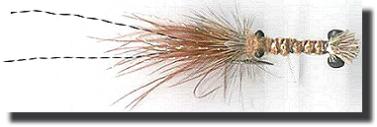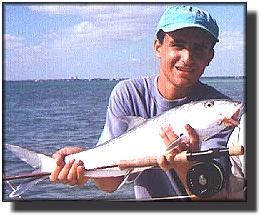Standing Shrimp
This fly was created by Eric Peterson for bonefish. Eric has
captured the vertical posture that a shrimp assume when
attacked by weighting the tail and locating a forked mono
weed/coral guard that act as "legs" that maintain the fly in the
standing posture. Selective bonefish may eagerly take this
fly, since it looks more like a shrimp than most patterns used
for bonefish. It's a good pattern for tailing bones, except for
extremely spooky bonefish, since the weight of the fly might
spook the fish on the impact. On this situation I prefer to use
a weightless fly. This fly has proved very good for me on
cruising fish in shallow water at Biscayne Bay, Florida.
Materials List:
Hook: TMC 811S or Mustad 34007; sizes 2, 4, 6
Thread: Rust or brown.
Mouth / Claws / Walking Legs: Pearl Krystal Flash,
brown marabou and cree saddle hackle (or cree grizzly).
Antennae: Two strands of black Krystal Flash.
Eyes: Small black plastic bead or burnt mono
painted black.
Weed/coral Guard: 20 lb. clear mono.
Weight: 1/8" lead barbell or medium bead
chain painted black for smaller hooks.
Tail: Fine brown bucktail or deer hair.
Body: Brown or gold Antron-type dubbing,
four strands orange Krystal Flash.
Carapace: The original call for single strand
of clear Larva Lace, but I prefer a clear strip of plastic, the
plastic that hooks and tying materials come in are very
good for this.
Rib:Tying Thread.
Tying Instructions:
1. Wrap thread from hook eye to bend of hook. Tie
in two strands of black Krystal Flash two-and-a-half times
shank length at the very start of the bend of the hook.
2. Tie the brown marabou of the length of the hook
shank than 3 strands of pearl Krystal Flash a bit shorter than
the marabou.
3. Tie the black plastic eyes then come back with
the thread and tie the cree hackle. Wrap the hackle 3 or 4
times around the shank and tie it off just before the eyes.
4. Now tie the weed/coral guard, which is the most important
part of this pattern, since is the weed/coral guard that will make the
fly stand up when sitting still on the bottom. Wrap the thread to
near the middle of the hook and tie the 20 lb. mono with
figure-eight wraps. Cut the two strands of mono to the desired
length, I like just a bit longer than the hook gape.
5. Wrap the thread to the hook eye and tie the
lead barbell on the underside of the hook.
6. Stack and tie in the brown bucktail just before
the lead barbell. The bucktail should lay in over back of the
hook and the natural tips of the bucktail should extend 1/2"
over the plastic eyes. Give the bucktail butts the approximate
shape of the tail of a shrimp, I use a rounded cut.
7. With the thread before the plastic eyes, apply
the dubbing and form a loop. Wrap the dubbing loop
around the plastic eyes and all the way to the lead barbell.
Cut it off.
8. With the thread just before the lead barbell, tie
3 or 4 strands of orange Krystal Flash and a fine strip of
clear plastic. Lay the Krystal Flash and the plastic strip over
the back and rib with the thread. Come back with the thread
to the starting point and whip finish. The Krystal Flash should
be two-thirds the lengh of the antennae (black Krystal Flash).
The plastic strip should extend about 1/3" over the plastic eyes.
9. Pick out the dubbing near the head of the shrimp
with a dubbing needle.


Fishing the Fly:
You should cast this fly in front, or in the possible path
of the bonefish. Give it some short strips until the fish sees
it, then let it drop so it stands on it's tail and watch the fish
to see the pick-up. If the fish loose interest, give the fly
some more strips.
~ Octavio Araujo – a.k.a. "Brazilian Guy"
Check out the new
TYING TIPS section!
|



